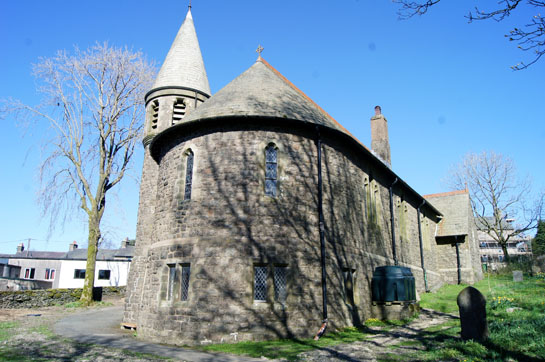|
Alphabetical List |
|
|
|
|
|
|
|
County List and Topics |
|
|
|
Please sign my Guestbook and leave feedback |
|
|
||||||||||||||||||||||||||||
|
legally unable to provide funds for the building of a church and parsonage in Tebay, so he appealed directly to the shareholders of what was then the London & North Western Railway. The directors made contributions. One was James Cropper MP who owned a paper mill at Burneside near Kendal. That company, still bearing his name, makes speciality papers to this day. The church was opened in 1880. It was designed by C.J.Ferguson who was a pupil of the famous George Gilbert Scott who was responsible for many a (not necessarily sympathetic!) church restoration in Victorian England. To my eyes, its biggest peculiarity is its apsidal west end. From the time of the Romans apses had always housed the altar and therefore had been situated at the east end of a church. There is a little bell tower with a conical roof rather like something out of a fairy tale castle! Despite its apse, the church is not a neo-Norman structure. Rather, with its lancet windows, it harks back to the Early English period. Internally this is an impressive building. Charmingly, the builders adopted the two-tone brick schema that was used on many of the L&NWR’s stations, including Manchester Piccadilly. It is simple in design - a nave and a chancel with an arch that spans virtually the entire church. The benches are of the same design as the L&NWR’s station benches of the time. Light floods in. It might not be ancient but it is an impressive and practical place of worship - although those benches look to be darned uncomfortable! Because the church is built on a slope there is a room below the apsidal part of the church and that is used now as a function room. The whole ambience is of a church that it is still very much at the hea The old SD&LR line actually passed close by the western end of the church. This must have been a noisy and smoky church in its heyday. There were benefits though: the railway gasworks used to supply the gas lighting and hot water for heating was pumped up from the engine shed! I don’t suppose I will persuade anyone to go far out of their way to visit this church but it really is worth a small detour if you are in the area if only to prove that the wealthy Victorians didn’t invariably have more money than good taste! |
 |
 |
||||||||||||
|
Left: The view towards the east with its lovely two-tone LNWR brickwork. Note the faux Early English triple lancet window. Note also the stone pulpit which matches the stone font. Right: The view west with its unusual apsidal shape. Note the railway bench seats! |
|||||||||||||
 |
 |
||||||||||||
|
Left: Looking into the apse. There is a display here explaining the church’s history and quite a lot of information about the railways. Note the beautifully-constructed window rebates. Right: The rather lovely roof beams over the apse. |
|||||||||||||
 |
 |
||||||||||||
 |
|||||||||||||
|
Left: The pulpit and the font were both made in 1930 from pink granite from Shap Fell just “up the road”. Shap Fell is an exhilarating view south from the nearby A6 road. In railway circles the fell is legendary for the strain its steep climb placed upon steam engines making the ascent. They often needed a “banker” loco at the rear to add muscle and Tebay’s engine shed was provided with locos for this purpose. Shap poses little challenge to today’s electric locomotives but that owes as much to the much shorter trains of today as to the efficiency of the power plant. Centre: The font. The inscription is - aptly - “Suffer Little Children to Come Unto Me”. The font cover is in the form of a spoked railway engine wheel. Right: The whimsical bell tower at the north west corner of the building. Note what was originally the vestry underneath the apse. This is now known as “The Hub” and used for community events. |
|||||||||||||
 |
|||||||||||||
 |
|||||||||||||
 |
|||||||||||||
|
Left Above: The church as seen from the south east from the road through the village. Left Below and Right: The base of the tower and the north porch. |
|||||||||||||
|
|
|||||||||||||
